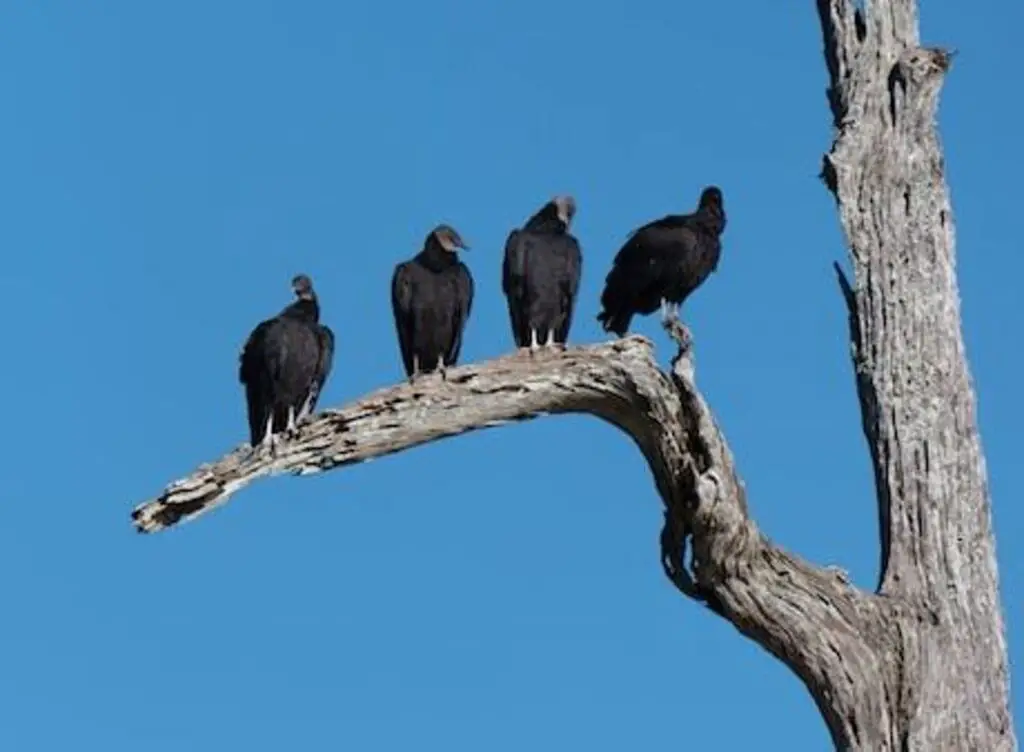Dive into the diverse world of Texas vultures with our comprehensive guide! From their unique characteristics to their vital role in the ecosystem, discover the various types of vultures that inhabit the Lone Star State.
Whether you’re a bird enthusiast or simply curious about local wildlife, join us as we explore the fascinating world of Texas vultures and learn more about these majestic birds that soar our skies.
Table of Contents
- 1 What are the Two Types of Vultures in Texas?
- 2 Turkey Vulture
- 3 Black Vulture
- 4 What Does a Turkey Vulture Look Like?
- 5 What Does a Black Vulture Look Like?
- 6 How Do These Two Types of Vultures Differ in Their Diet?
- 7 What is the breeding behavior of Turkey vultures in Texas?
- 8 How do Black vultures breed and raise their young in Texas?
- 9 How Far Can These Two Types of Vultures Fly?
- 10 Do These Two Types of Vultures Live in Different Areas?
- 11 How Do These Two Types of Vultures Behave Around Each Other?
- 12 What Are the Benefits of Having Both Types of Vultures in Texas?
- 13 Some Facts About Vultures in Texas
- 14 FAQs About Vultures in Texas
- 14.1 What types of vultures can be found in Texas?
- 14.2 What do vultures eat in Texas?
- 14.3 Are vultures dangerous to humans?
- 14.4 Where do vultures live in Texas?
- 14.5 How long do vultures live in Texas?
- 14.6 What is the role of vultures in the ecosystem?
- 14.7 Do vultures migrate in Texas?
- 14.8 How can you identify a vulture in Texas?
- 14.9 Can you keep vultures as pets in Texas?
- 14.10 Are vultures declining in population in Texas?
- 15 Conclusion
- 16 Author
What are the Two Types of Vultures in Texas?
Texas is home to two unique types of vultures – the turkey vulture and the black vulture. Both of these birds of prey have distinct physical characteristics and behaviors that make them interesting to observe and learn about. The turkey vulture is larger and has a reddish-brown plumage.
It has a wingspan of up to 6 feet and can be seen soaring through the skies of Texas. The black vulture is smaller, with a glossy black plumage, and has a wingspan of up to 4.5 feet. These two types of vultures are similar in some ways, but also differ in others. Read on to learn more about their diet, wingspan, and more!
Turkey Vulture
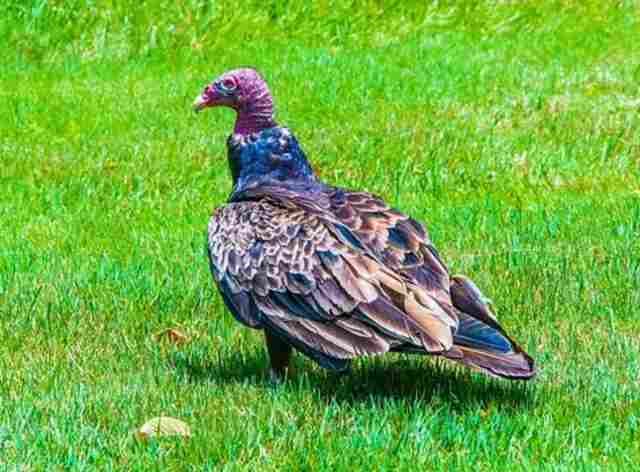
The Turkey Vulture is one of two types of vultures found in Texas. It has a distinctive red-brown plumage and an impressive wingspan, reaching up to six feet in length. The head and neck are featherless and grayish, with a bald and wrinkled appearance. It is also the larger of the two species, with a body length of up to three feet.
The Turkey Vulture is an opportunistic scavenger, primarily feeding on the carcasses of dead animals. It is also known to feed on eggs, nestlings, and fruits. It can fly up to 150 miles in a single day, and roosts in large numbers in trees or cliffs.
This species prefers to live in open areas, such as grasslands, deserts, and woodlands. It is also common in urban areas, and can sometimes be seen soaring in the skies above.
Black Vulture

The Black Vulture is one of two types of vultures that are found in Texas. It is easily distinguishable from the Turkey Vulture due to its black feathers and white head. The Black Vulture is slightly larger than the Turkey Vulture, with an average wingspan of up to 63 inches. It is also heavier than the Turkey Vulture, weighing up to 3.2 pounds.
The Black Vulture mainly feeds on carrion, but will also eat other animals, including smaller birds, eggs, and small mammals. It prefers to scavenge rather than hunt, but it can be aggressive when competing with other scavengers for food. The Black Vulture is also known to scavenge from garbage sites.
The Black Vulture can be found in most parts of Texas but is more common in the southern and eastern parts of the state. It prefers wooded areas but can also be found in grasslands and other open areas.
The Black Vulture often rivals the Turkey Vulture for food resources. It is also known to be more aggressive and territorial than the Turkey Vulture, often chasing away other scavengers in order to claim a food source for itself.
What Does a Turkey Vulture Look Like?
The turkey vulture is one of the two types of vultures that can be found in Texas. A bird of considerable size, with a wingspan that can reach up to 6 feet. Its plumage is mostly black, with a reddish-brown head, neck, and breast. Its bare head and neck are a yellowish-gray color.
The turkey vulture is one of the larger birds of prey, with a body size of up to 24 inches in length. It has a very distinctive silhouette, with long wings and a broad, rounded tail. Its wings are broad and V-shaped, and its flight is graceful and soaring.

Plumage
The Turkey Vulture has a feathery brown and black plumage, while the Black Vulture has a glossy black plumage with a silvery sheen. The Turkey Vulture is often identified by its red head, while the Black Vulture has a featherless, wrinkled head. Both species have a white patch on the underside of the wing, which is used for identification.
Size
The size of both the Turkey Vulture and Black Vulture is quite impressive. The Turkey Vulture is larger than the Black Vulture, with an average length of 24 to 32 inches (60 to 80 cm) and a wingspan of up to 6.5 feet (2 m).
The Black Vulture is smaller, with an average length of 20 to 24 inches (50 to 61 cm) and a wingspan of up to 4.5 feet (1.4 m). Both of these large birds are quite impressive to observe in flight.
Wingspan
Turkey Vultures have a wingspan of up to six feet and are often seen soaring through the skies with their long wings outstretched. The Black Vulture has a wingspan of around five feet and is usually seen soaring lower than the Turkey Vulture.
Both of these vultures can be seen flying high in the sky, but the Black Vulture stays closer to the ground. Their wingspan is impressive and allows them to travel great distances in search of food.
| Characteristics | Description |
|---|---|
| Plumage | Feathery brown and black plumage; red head, neck, and breast; white patch on underside of wings |
| Size | Up to 24 inches in length; wingspan up to 6.5 feet |
| Wingspan | Up to 6 feet; broad, V-shaped wings |
| Habitat | Found in a variety of habitats including forests, grasslands, and deserts |
| Diet | Feeds primarily on carrion, but will also eat eggs and live prey if necessary |
| Behavior | Soars high in the sky on thermal updrafts; flies in a wobbly, rocking motion |
| Conservation Status | Least Concern |
Note: This information is based on general characteristics of the Turkey Vulture and may vary slightly depending on the specific region or subspecies.
What Does a Black Vulture Look Like?
A black vulture is a large bird with dark gray to black feathers and a white head. Its wingspan can reach up to five feet and its body length can reach up to two feet. The black vulture also has a large, hooked beak and long toes.
Its eyes are yellow, and its legs are bare. The black vulture is one of the most graceful fliers in the sky, and its wings are broad and curved. It also has a distinctive white rump patch, which is visible when it flies. The black vulture is a solitary bird, but it can sometimes be seen in small flocks.
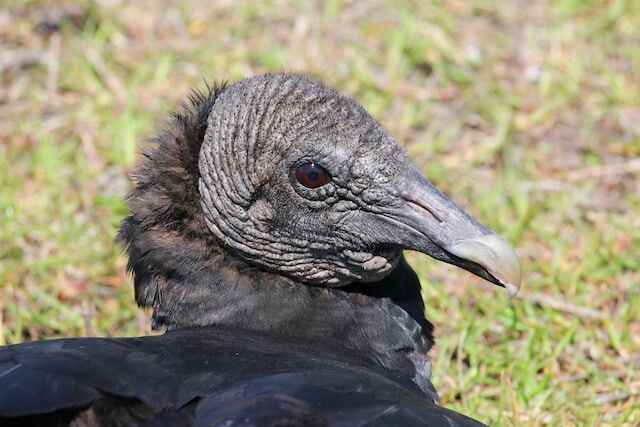
Plumage
The Turkey Vulture is easily distinguishable by its brownish-black plumage, which covers its head, neck, and upper wings. In contrast, the Black Vulture has a black body with a white rump and a gray head.
Both species have long, broad wings with a wingspan of up to 5 feet! The Turkey Vulture has a distinctive white band along its wings, while the Black Vulture does not.
Size
The size of both the Turkey Vulture and the Black Vulture varies depending on the region. Generally, the Turkey Vulture is larger with a body length of up to 25 inches and a wingspan of up to 60 inches. The Black Vulture, on the other hand, is much smaller with a body length of about 15 inches and a wingspan of up to 47 inches.
The Turkey Vulture also has a longer tail than the Black Vulture, further emphasizing the difference in size between the two. The Turkey Vulture is also heavier, weighing up to 4 pounds, while the Black Vulture only weighs up to 2.5 pounds.
Wingspan
The wingspan of a Turkey Vulture is typically around 4 to 6 feet, while the wingspan of a Black Vulture is a bit smaller, at around 4 feet. Both species have long, wide wings that allow them to soar through the air with ease and grace. They both have curved wings which help them gain lift, allowing them to fly for longer distances.
The wingspan of a Turkey Vulture is slightly longer than that of a Black Vulture, but both species have impressive wingspans that make them capable of long-distance flight.
| Feature | Black Vulture Description |
|---|---|
| Plumage | Black body with white rump and gray head |
| Wingspan | Up to 5 feet |
| Body length | About 15 inches |
| Beak | Large and hooked |
| Eyes | Yellow |
| Legs | Bare |
| Flight | Graceful flier with broad and curved wings |
| Flocking | Solitary bird, but can sometimes be seen in small flocks |
| Weight | Up to 2.5 pounds |
Note: This information is based on general characteristics of the Black Vulture and may vary slightly depending on the specific region or subspecies.
How Do These Two Types of Vultures Differ in Their Diet?
When it comes to the diet of Texas’s two types of vultures, there are distinct differences between them. The Turkey Vulture, for instance, primarily feed on carrion (dead animals). They may also supplement their diet with fruit, insects, and eggs. On the other hand, Black Vultures mostly feed on carrion, but they also scavenge for food scraps in garbage cans, farms, and other areas.
They will also occasionally hunt small animals, such as newborn mammals or reptiles. Therefore, it’s important to remember that these two types of vultures have different diets, which can help them survive and thrive in their respective habitats.
Turkey Vulture
The Turkey Vulture (Cathartes aura) is a species of vulture native to Texas, and one of the two types of vultures found in the state. It is a large bird, with a wingspan of up to 6.2 feet, and a distinctive red or orange head with a bald neck and face. The body of the adult Turkey Vulture is black or dark brown, with a white tail and underparts.
It feeds mainly on carrion, including the carcasses of animals, and can be seen soaring high in the sky looking for food. It is also known to scavenge from garbage or from the nests of other birds. The Turkey Vulture is found in a wide range of habitats, including woodlands, deserts, and grasslands.
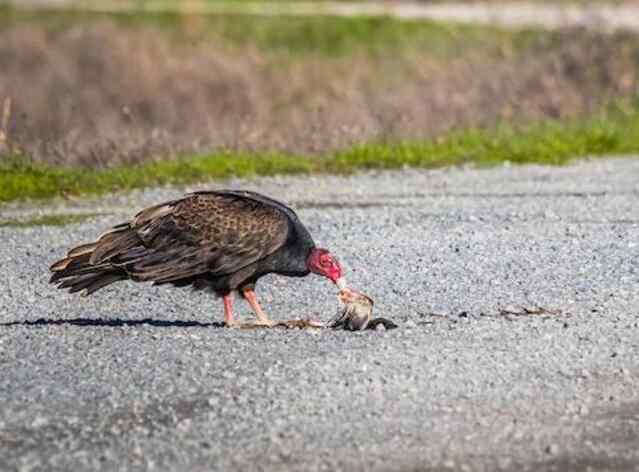
Black Vulture
The Black Vulture is one of two types of vultures found in Texas. This bird is much smaller than the Turkey Vulture and has a distinct black plumage. It has a wingspan of up to 4 feet and generally weighs between 1.5 and 2.5 pounds. The Black Vulture’s diet consists of carrion, eggs, fruits, and small mammals.
They can fly for up to 100 miles in a single day and are often seen in open areas, such as grasslands, pastures, and agricultural lands. Black Vultures are known to be more aggressive than Turkey Vultures and will often try to drive them away from food sources. They also have a more varied diet, which can be beneficial to the local ecosystem.
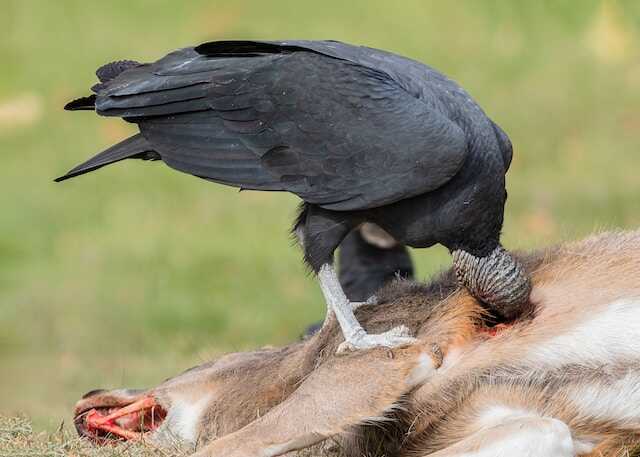
What is the breeding behavior of Turkey vultures in Texas?
The breeding behavior of Turkey vultures in Texas is quite fascinating. These birds mate for life and engage in courtship rituals, such as soaring together and mutual preening.
The female turkey vulture lays her eggs in a secluded area, such as a cave or hollow tree, and both parents take turns incubating them.
After hatching, the chicks are fed regurgitated food by both parents until they are old enough to leave the nest.
Turkey Vulture Breeding Information Table
| Turkey Vulture | |
|---|---|
| Breeding season | March to July |
| Mating behavior | Monogamous |
| Nesting location | Ground or in caves |
| Nesting materials | None or minimal |
| Clutch size | 1-3 eggs |
| Incubation period | 38-41 days |
| Fledging period | 60-80 days |
How do Black vultures breed and raise their young in Texas?
Similarly, the breeding behavior of black vultures in Texas is also interesting. These birds typically breed in large colonies and form pair bonds that last for years. The female lays one to three eggs in a tree or on the ground, and both parents take turns incubating them.
Once hatched, the chicks are fed by regurgitation from both parents until they fledge and begin to fly on their own. The young black vultures may stay with their parents for several months before venturing out on their own.
Black Vulture Breeding Information Table
| Black Vulture | |
|---|---|
| Breeding season | February to June |
| Mating behavior | Monogamous |
| Nesting location | Caves, hollow trees or logs, abandoned buildings |
| Nesting materials | Sticks, bark, leaves, grass |
| Clutch size | 1-3 eggs |
| Incubation period | 36-41 days |
| Fledging period | 60-70 days |
How Far Can These Two Types of Vultures Fly?
When it comes to flight, both types of vultures in Texas have impressive wingspans. The Turkey Vulture has a wingspan of up to 6 feet, while the Black Vulture can reach an impressive wingspan of up to 7 feet. With these wings, both types of vultures can cover great distances in the air.
The Turkey Vulture is able to travel up to 200 miles per day, while the Black Vulture can reach up to 400 miles a day. This means both types of vultures in Texas are incredibly capable flyers and can cover large distances in a relatively short amount of time.
Turkey Vulture
The Turkey Vulture is one of two types of vultures that can be found in Texas. This bird has a unique look, with its dark brown plumage, short tail, and distinctive red head. It is also larger than the Black Vulture, with an average wingspan of 5.5 to 6.5 feet.
When it comes to its diet, the Turkey Vulture is a scavenger, feeding mainly on carrion, but it will also eat insects and other small animals. It is also capable of flying up to 150 miles in a single day, and can be seen in a variety of habitats, from deserts to grasslands and forests.
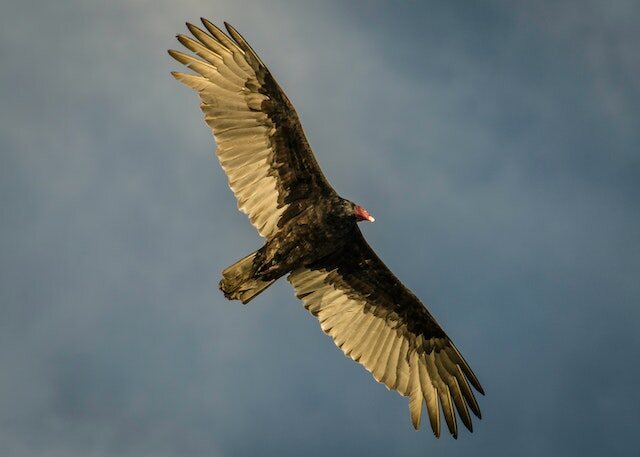
Black Vulture
The Black Vulture is one of the two types of vultures found in Texas. They have predominantly black plumage, with white patches on the underside of their wings and a white head. They are the smaller of the two vultures, typically reaching a size of about 25 inches tall and having a wingspan of about 4 feet. These birds have a different diet than the Turkey Vulture, preferring to scavenge for carrion and eat eggs and nestlings.
They also have a greater range and can be seen soaring up to 500 miles away. Black Vultures are known to be more aggressive than Turkey Vultures and will sometimes fight with them if they come too close to their food or nest. Despite this, they provide a great benefit to Texas by helping to keep the environment clean and healthy.
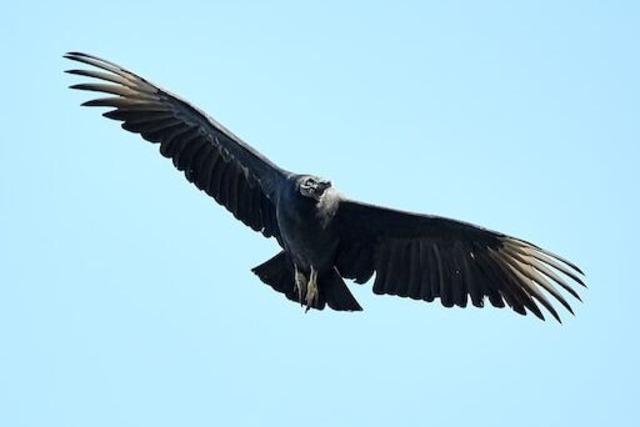
Do These Two Types of Vultures Live in Different Areas?
When it comes to the habitats of the two types of vultures that live in Texas, there is a distinct difference. The Turkey Vulture is found in a wide variety of habitats, ranging from forests, deserts, and mountains to grasslands and cities.
On the other hand, the Black Vulture is typically found in more open areas, such as pastures, fields, and savannahs. While the two species sometimes overlap in habitat, the Black Vulture is usually found in more arid areas than the Turkey Vulture.
Turkey Vulture
The Turkey Vulture is a large bird of prey that is native to Texas and can be found across much of the state. It has a distinctive black and red plumage, and can grow up to around two feet in length. It also has a wingspan of up to six feet, allowing it to soar gracefully through the air.
Its diet consists mainly of carrion and other small animals, making it an important part of the local ecosystem. It is also known to migrate long distances, with some individuals travelling up to 1,000 miles in a single trip. The Turkey Vulture can typically be found in open areas, such as pastures and grasslands, but can also be seen in wooded areas.
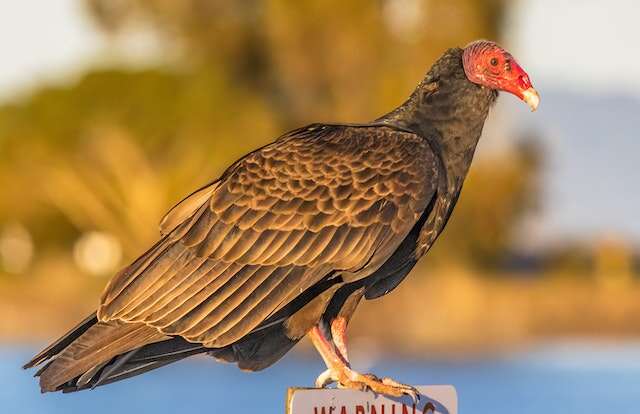
Black Vulture
The Black Vulture is one of the two types of vultures found in Texas. It is easily distinguishable from the Turkey Vulture due to its black plumage and white wingtips. The Black Vulture is also smaller in size, with an average length of 22-25 inches and a wingspan of 4.5-5.5 feet.
Unlike the Turkey Vulture, the Black Vulture has a slightly more carnivorous diet, feeding on carrion and small animals such as rodents and reptiles. The Black Vulture can fly up to 30 miles in one day, and is typically found in wooded areas, while the Turkey Vulture is more likely to inhabit open grasslands.
When it comes to behavior, the Black Vulture is known to be more aggressive and confrontational than the Turkey Vulture, often chasing them away from their food sources. Despite its more predatory nature, the Black Vulture is an important part of the ecosystem, helping to keep the environment clean by scavenging on dead animals.

How Do These Two Types of Vultures Behave Around Each Other?
When two types of vultures come into contact with one another, the behavior of the birds typically depends on the species. Turkey vultures are more passive and will often take a step back in the presence of a black vulture. Black vultures, on the other hand, are more aggressive and will often be seen chasing away the turkey vultures.
They will also compete with one another for food and nesting sites. Despite the different behaviors of these two species, they are often seen in close proximity and have been known to roost in the same tree.
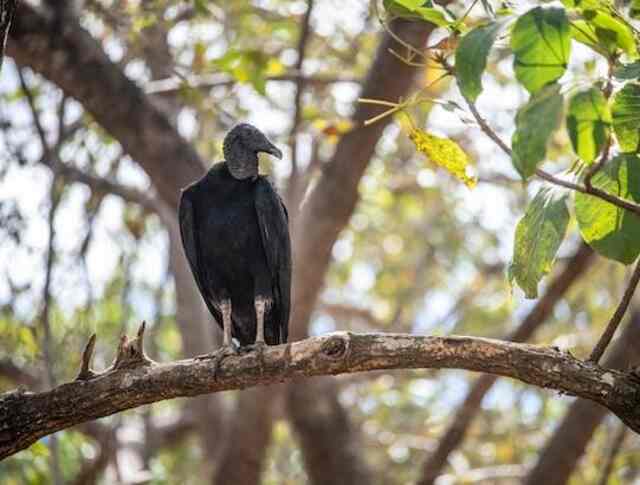
What Are the Benefits of Having Both Types of Vultures in Texas?
Having both types of vultures in Texas are a great benefit to the environment. Turkey vultures help keep the area clean by eating dead animals and other decaying matter, while black vultures help keep the population of small animals in check. This helps to keep the ecosystem balanced and healthy.
Additionally, having both of these birds in the area helps ensure a more diverse and healthy population of birds, which can help bring more color and life to the area. With these two species of vultures living in harmony, Texas can enjoy a more vibrant ecosystem with more diverse wildlife.
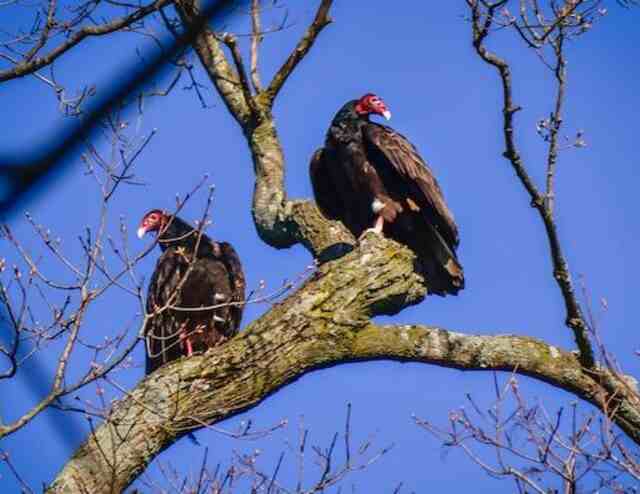
Some Facts About Vultures in Texas
- Fact: Vultures have amazing eyesight, which allows them to locate food from great distances.
- Fact: Vultures help clean the environment by feeding on carrion, which helps prevent the spread of disease.
- Fact: Vultures are excellent fliers, able to soar for hours without flapping their wings.
- Fact: Vultures are solitary birds and do not form large flocks like other birds.
- Fact: Vultures have very acidic stomachs, which allow them to digest carrion that would be toxic to other animals.
- Fact: Vultures have bald heads, which helps prevent bacteria and other debris from sticking to their feathers while feeding.
- Fact: Black vultures can be found throughout Texas, particularly in the southern and eastern regions.
- Fact: Black vultures are a species of least concern in Texas and are not currently considered to be at risk.
- Fact: Turkey vultures can be found throughout Texas, particularly in the western and central regions.
- Fact: Turkey vultures are a species of least concern in Texas and are not currently considered to be at risk.
FAQs About Vultures in Texas
What types of vultures can be found in Texas?
There are two types of vultures that are commonly found in Texas: the black vulture and the turkey vulture.
What do vultures eat in Texas?
Vultures in Texas mainly feed on carrion, which includes dead animals like cattle, deer, and other wildlife.
Are vultures dangerous to humans?
Vultures are generally not dangerous to humans. They do not attack or prey on live animals, and they usually avoid human contact.
Where do vultures live in Texas?
Vultures in Texas can be found in various habitats, including forests, grasslands, and urban areas.
How long do vultures live in Texas?
Vultures in Texas can live up to 20 years in the wild.
What is the role of vultures in the ecosystem?
Vultures play a crucial role in the ecosystem by helping to clean up carrion and preventing the spread of diseases.
Do vultures migrate in Texas?
Some vultures in Texas are migratory, while others are non-migratory.
How can you identify a vulture in Texas?
Vultures in Texas can be identified by their large size, dark feathers, bald heads, and hooked beaks.
Can you keep vultures as pets in Texas?
It is illegal to keep vultures as pets in Texas, as they are protected by federal and state laws.
Are vultures declining in population in Texas?
There is no evidence to suggest that vultures in Texas are declining in population. However, their numbers may be affected by habitat loss and other environmental factors.
Conclusion
In conclusion, it’s clear that Texas is home to two types of vultures – the turkey vulture and the black vulture. Both of these birds have distinct looks, diets, and behaviors. The turkey vulture is larger in size and has a wingspan of up to six feet. It mainly eats carrion and is found in open areas.
The black vulture is smaller and has a wingspan of up to four feet. It mainly eats eggs and is found in wooded areas. The two types of vultures have different habitats, but they do interact with each other.
By having two types of vultures in Texas, the environment benefits from their scavenging habits and the cycle of life is maintained. So, now that you know all about the incredible facts about Texas’s two types of vultures, you can appreciate these birds even more.
Related Post:

